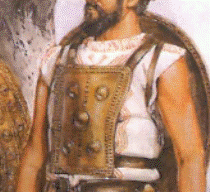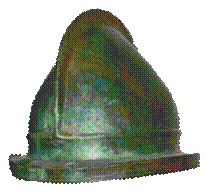

Roman Republic
Although there is no evidence to support this claim, legends have it that Rome was founded in 753 B.C. by Romulus. Rome was under Etruscan rule for 2 centuries before it became a republic. Rome expanded into a vast empire from a mixture of subjugation and politics until its fall in 410 A.D. Although part of the empire continued after that date it changed dramatically and became a new empire entirely which came to be known as the Byzantine Empire. The Roman civilization is one of the most widely studied civilizations and tremendous amounts of information exist concerning it in the form of books and websites.
Being a young nation and under the control of the Etruscan, the Roman civilization borrowed from other designs of their time and made it their own; The most notable of which is the scutum shield, which was different then all the other shields of the region. The material used in making their armor at this time was mostly bronze and very few iron.
HELMETS |
|
|
Name: Negau helmet. Origin: 6-4th century BC. Excavated in Zenjak, Styria near Negau; now Negova, Gornja Radgona, Slovenia. A Negau helmet can be thought of as a Villanovan helmet with an added L shape bottom section and a truncated top section. The shape of the helmet is credited to the Etruscan town of Vetulonia formerly known as Vetluna. This is why the helmet possesses a resemblance to the Villanovan helmets. |
|
CUIRASS |
|
 McNab, Chris. The Roman Army: The Greatest War Machine of the Ancient World. |
Name: Square breastplate. Origin: 4th-2nd century BC. The square breastplate existed long before the rise of the Roman republic but did not come into wide spread use until the 4th century BC. Square breastplates are rectangular in shape, with curving sides, with typically a little less than 20cm in width and a little more than 20cm in length, and were presumably worn with the long side running vertically. |
SHIELDS |
|
|
Name: Oval Scutum. Origin: 4th-2nd century BC. The oval scutum is a long curved body shield used mostly by the infantry of the Roman army. It covers more parts of the body then the clypeus and could cover the entire body when its bearer kneeled on the ground. Some typical dimensions for the oval scutum are 75cm in width and 1.2m in height. |
|
GREAVES |
|
|
At this point in time a Roman soldier would wear a Greek style cuirass. Those who could afford it wore one on each leg, but those who could not only wore one on their left leg. This was so because of the Roman legionnaire fighting style that placed the left leg forward in harm’s way while the right leg stayed safely in the back. |
|


Integrative Materials Design Center - Worcester Polytechnic Institute

